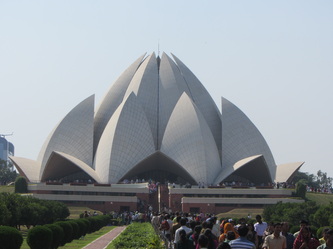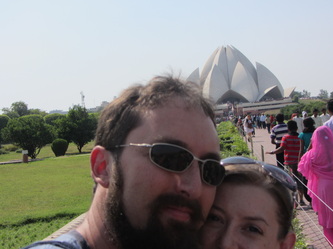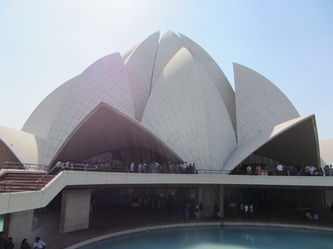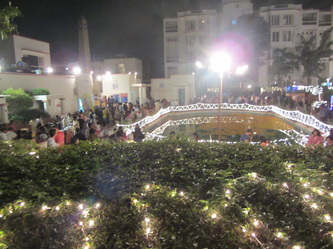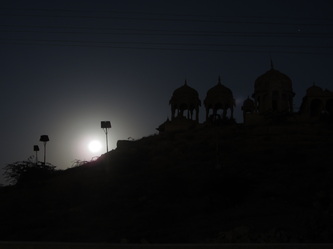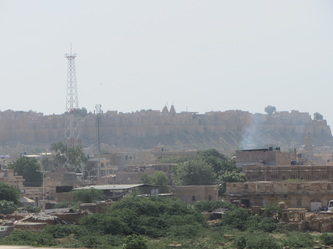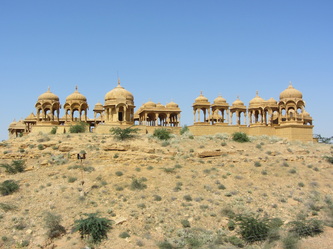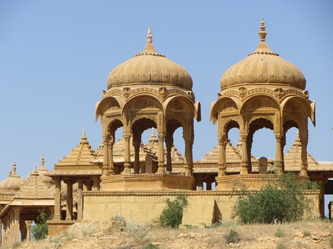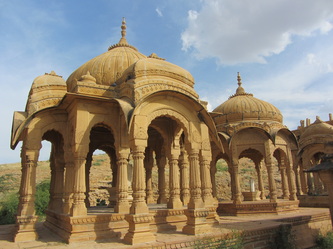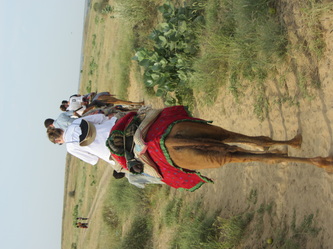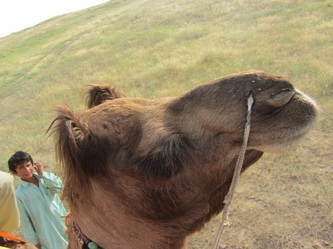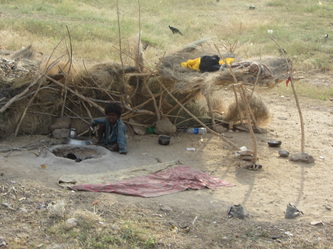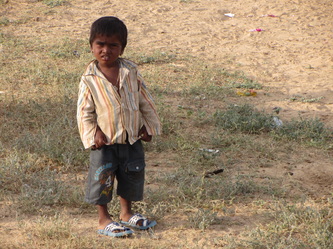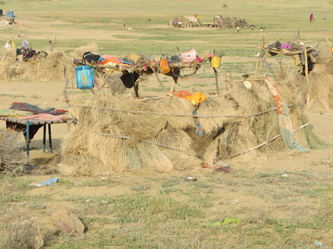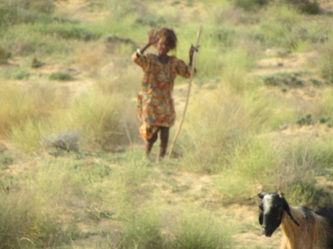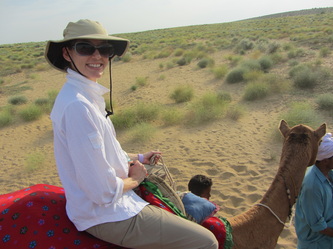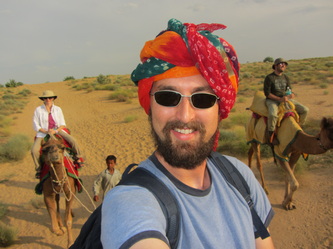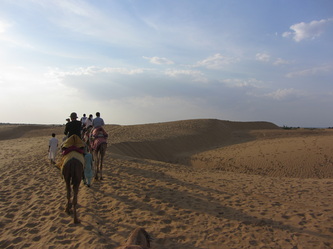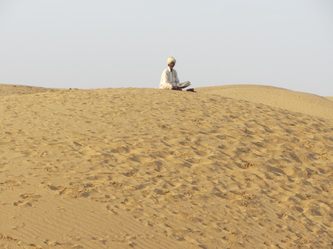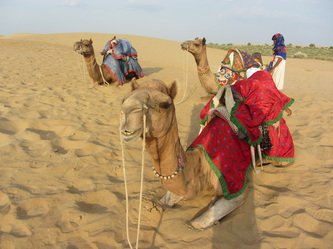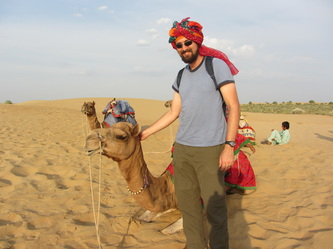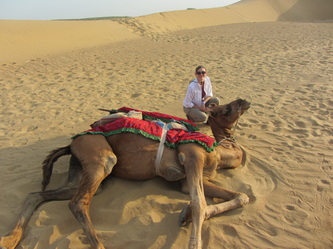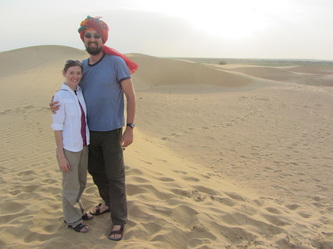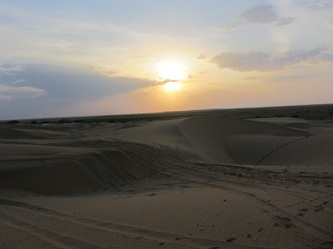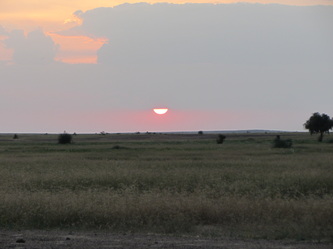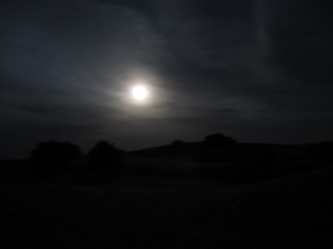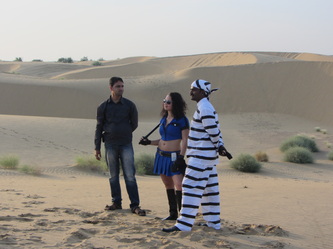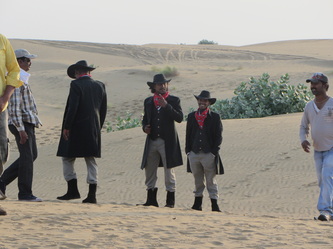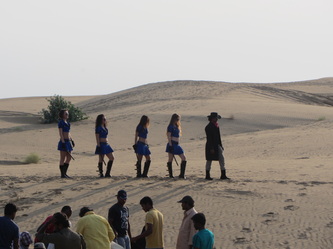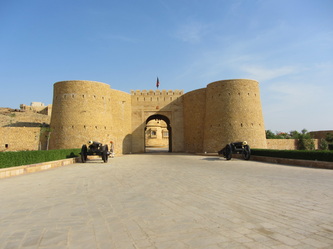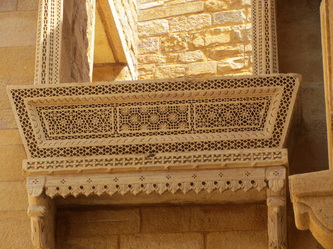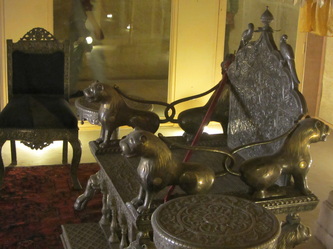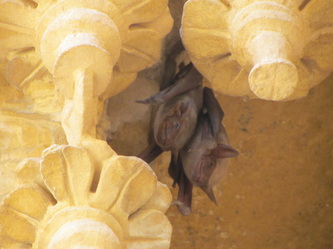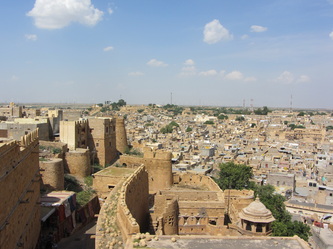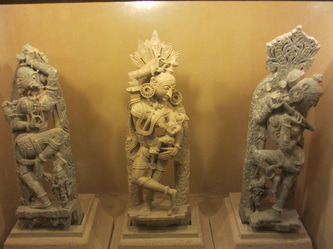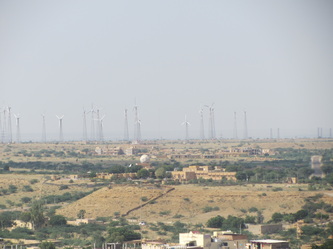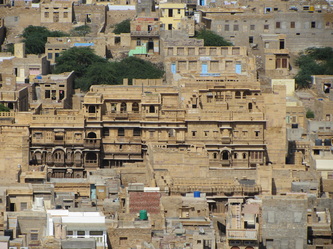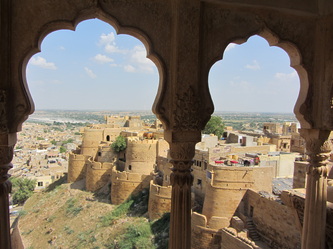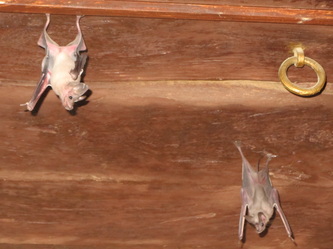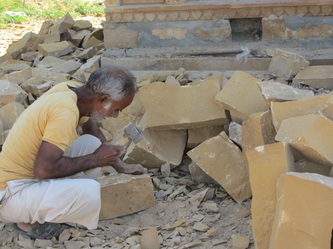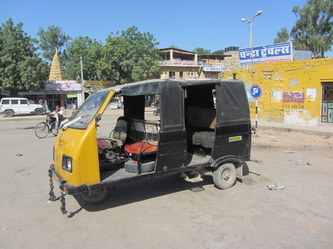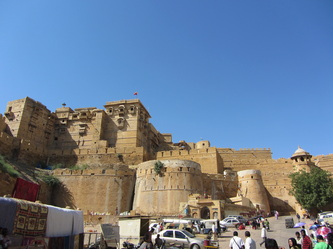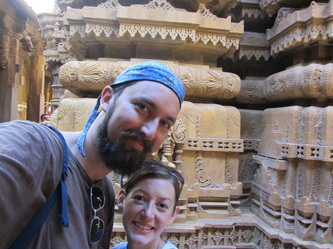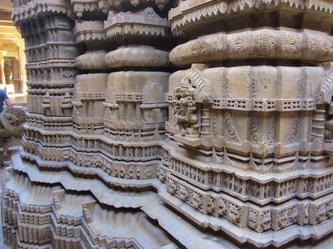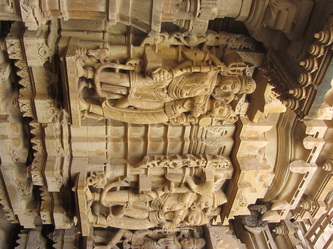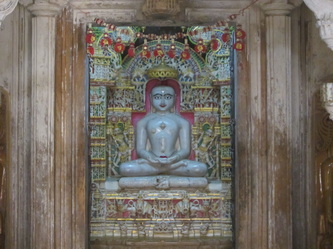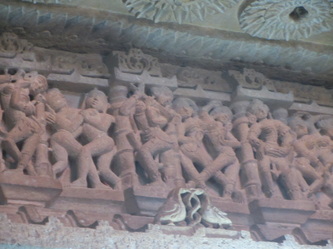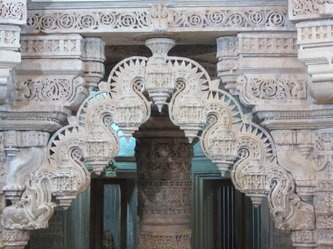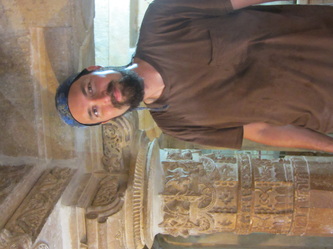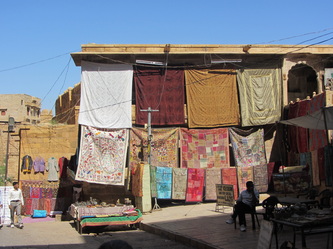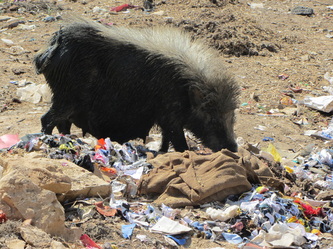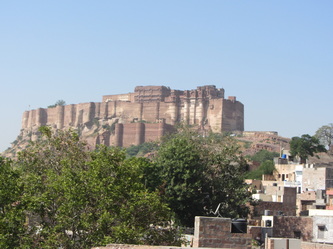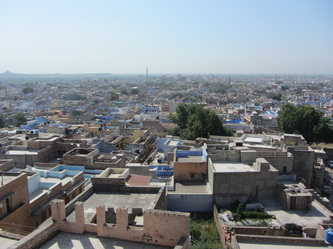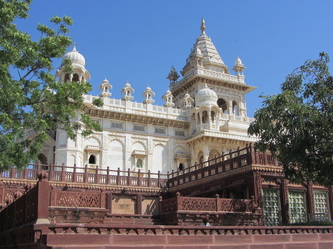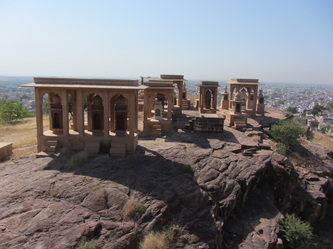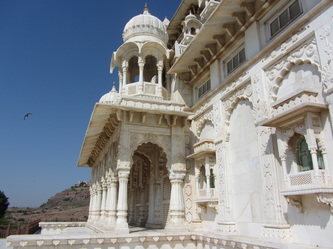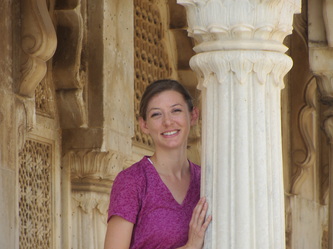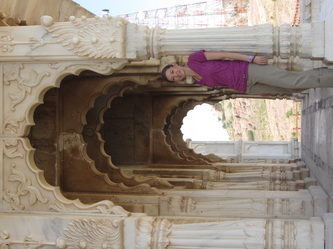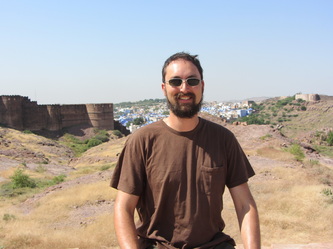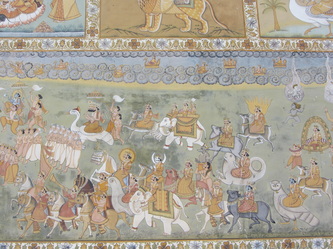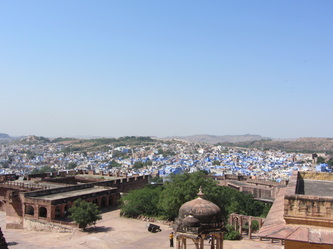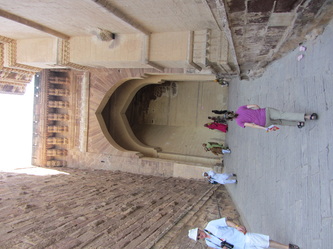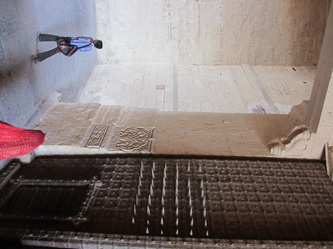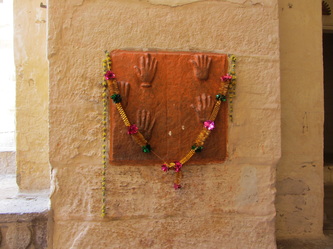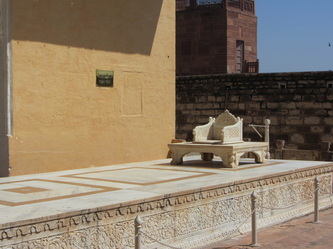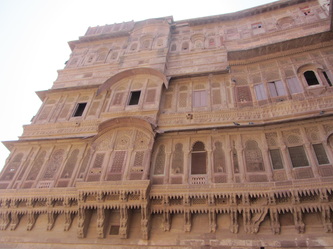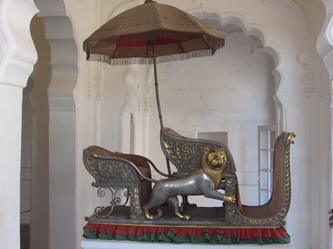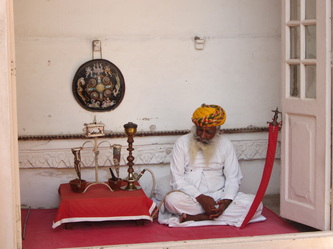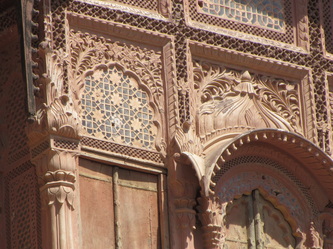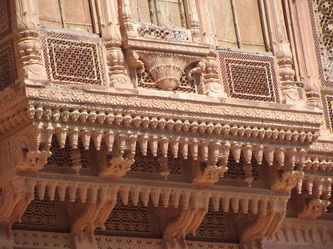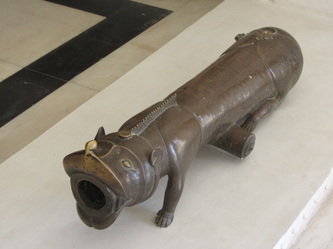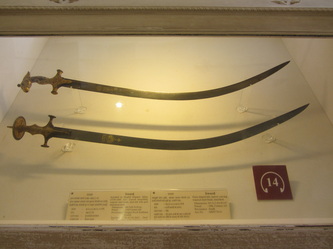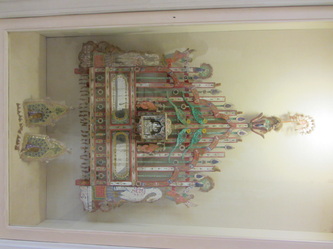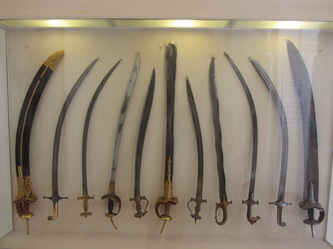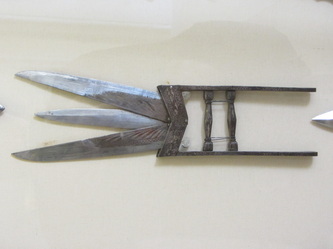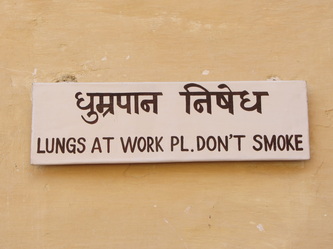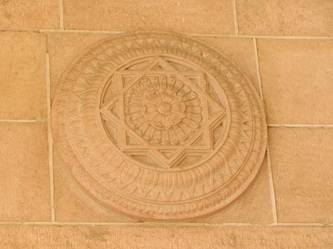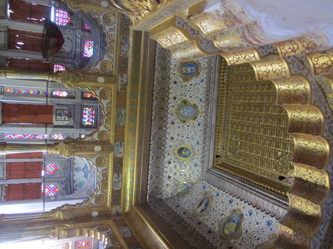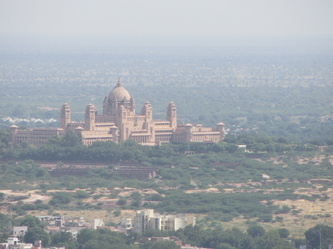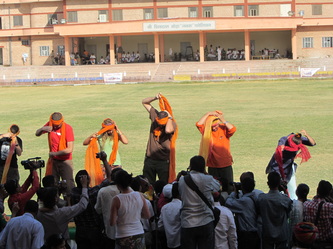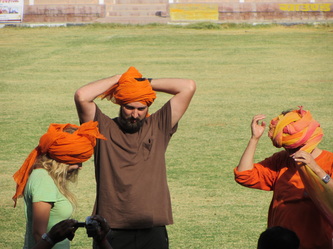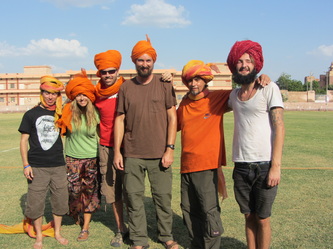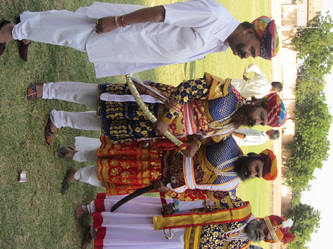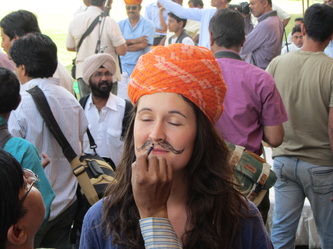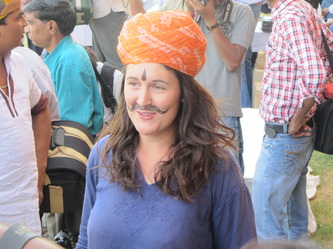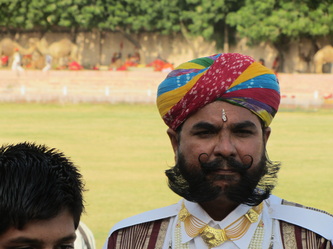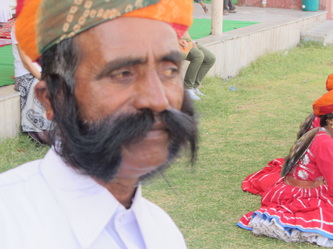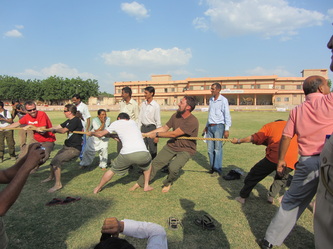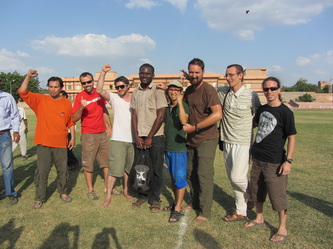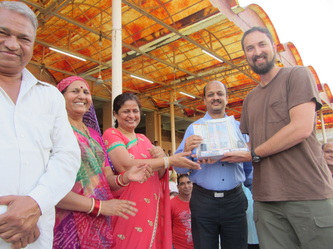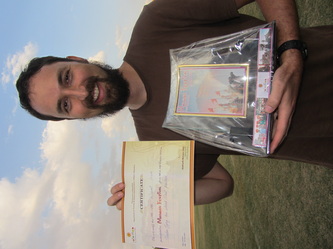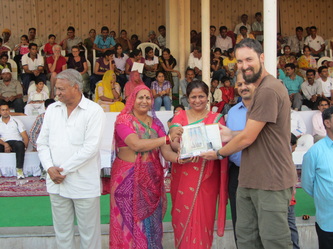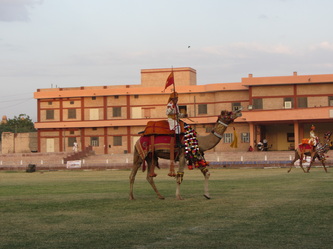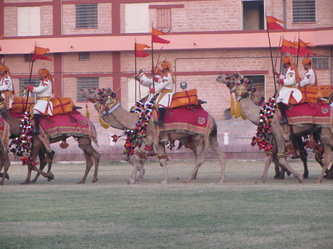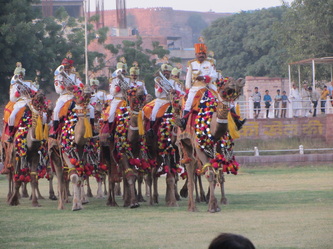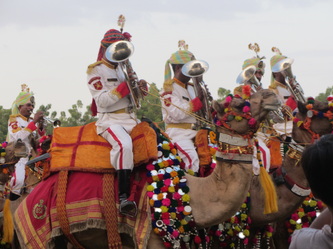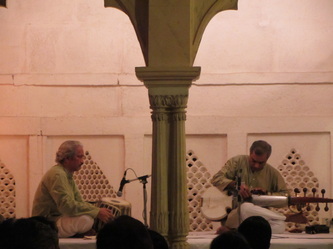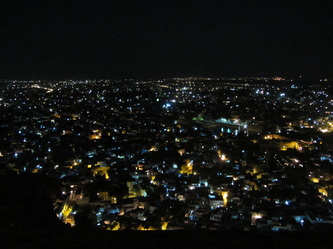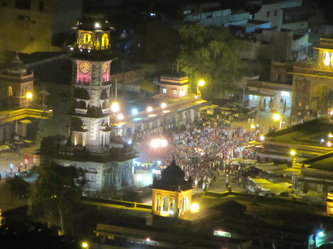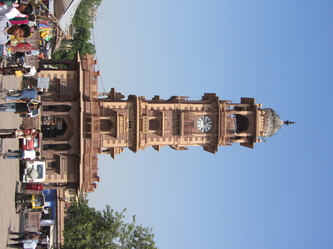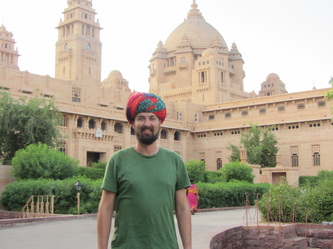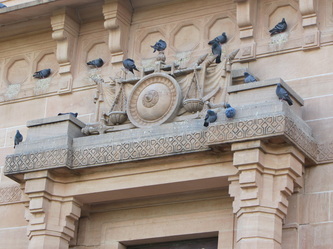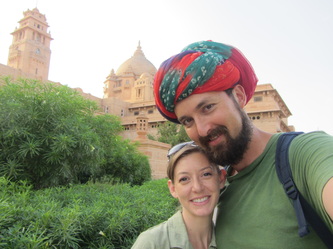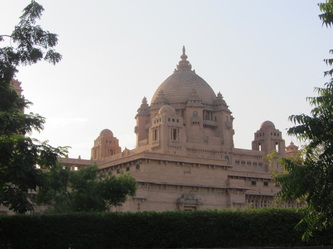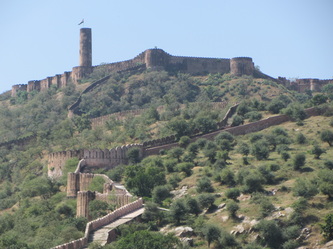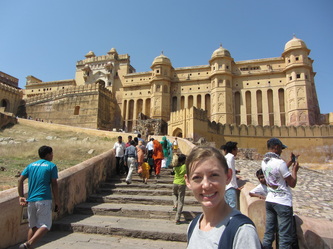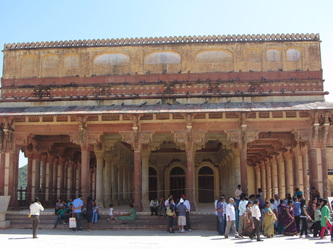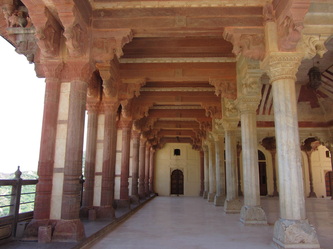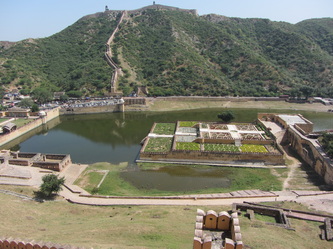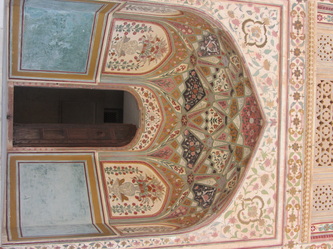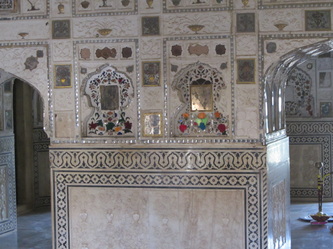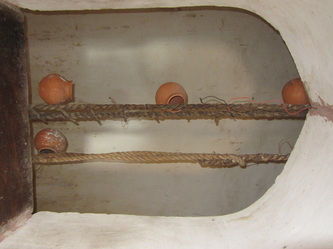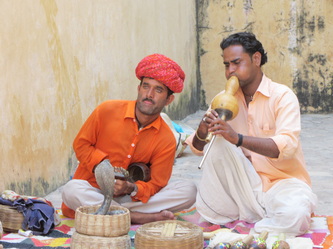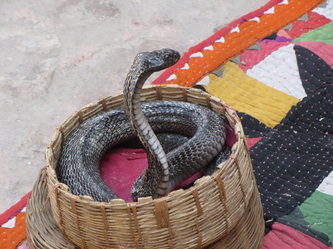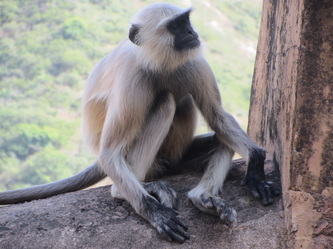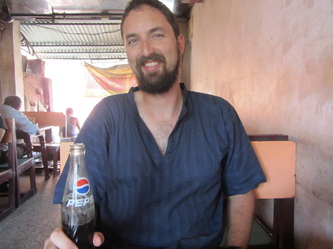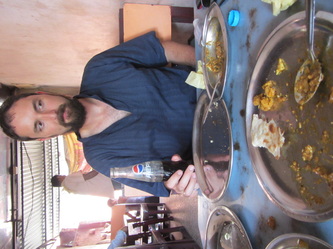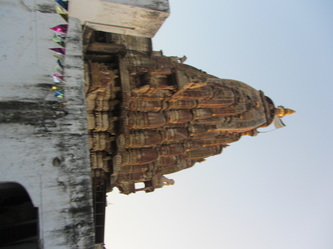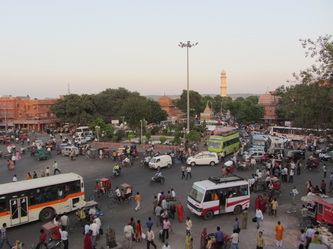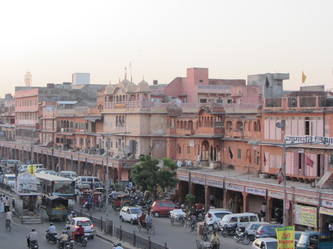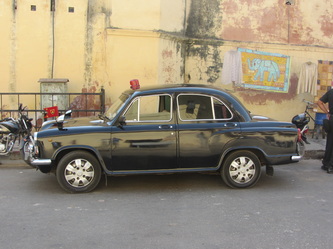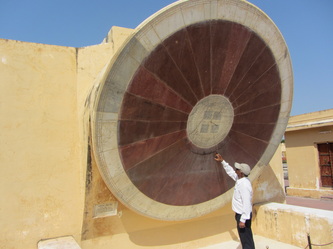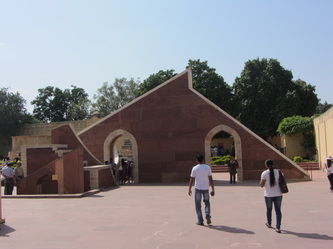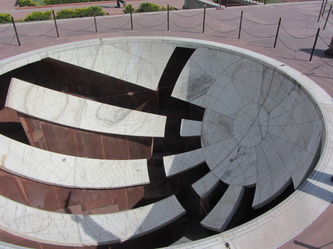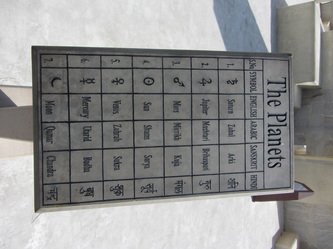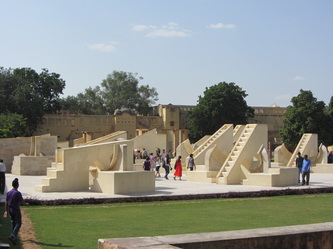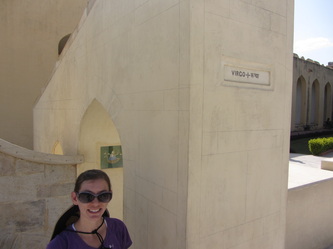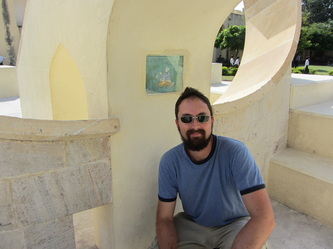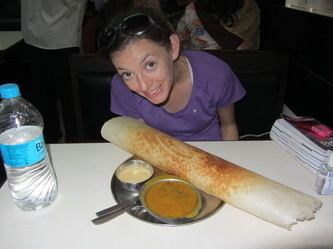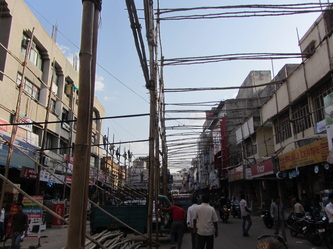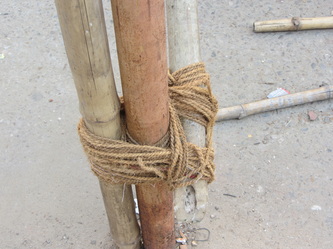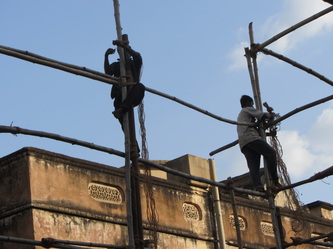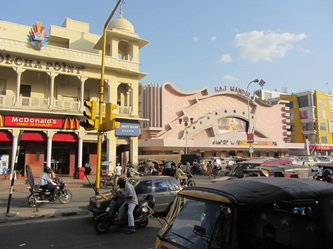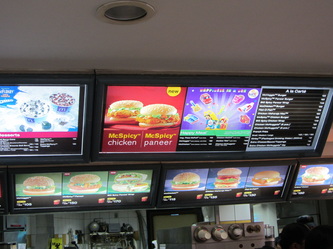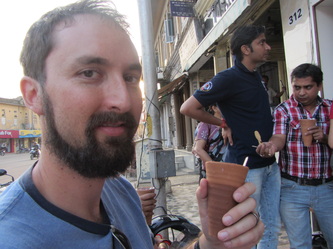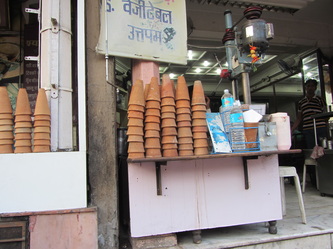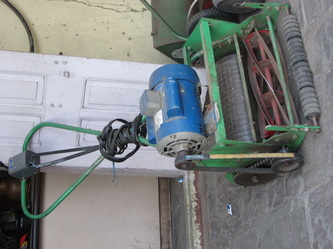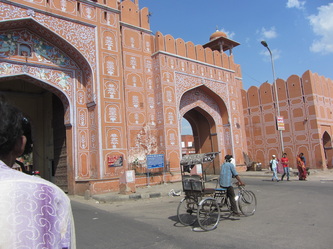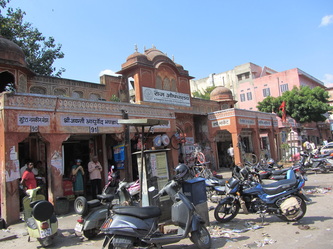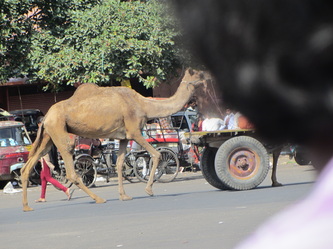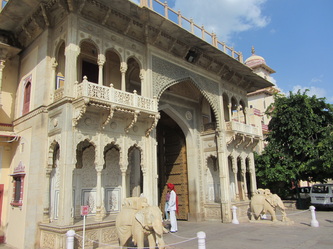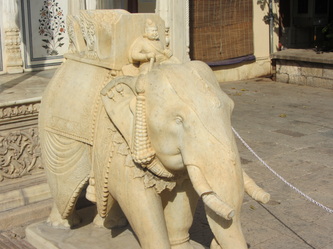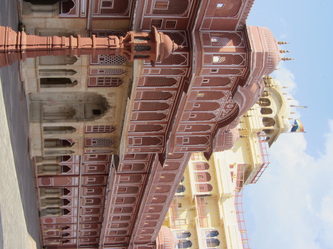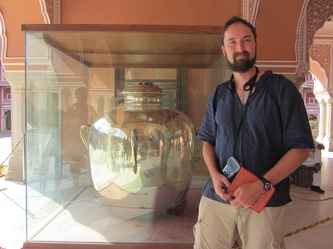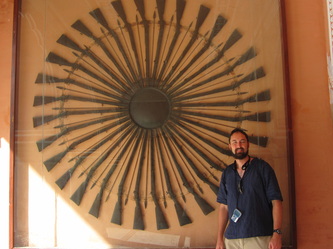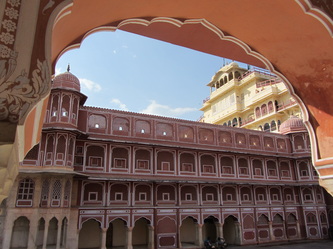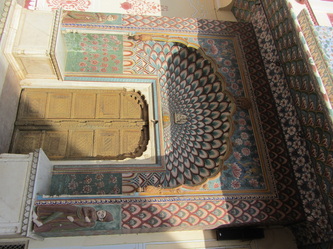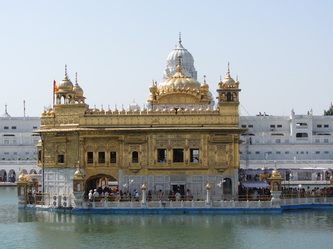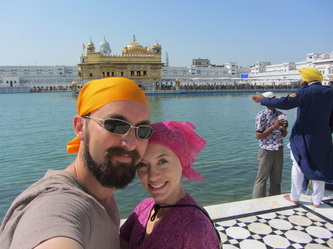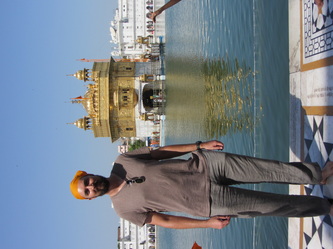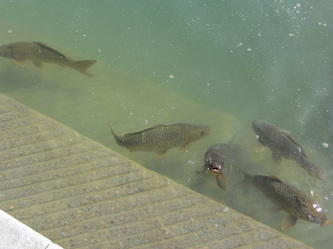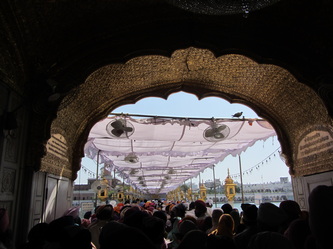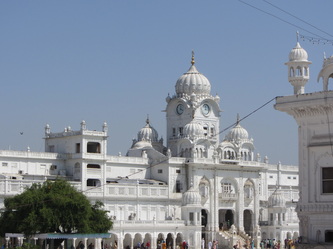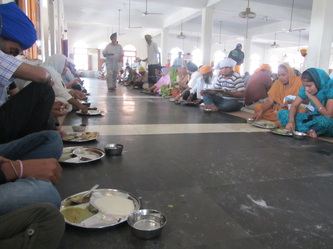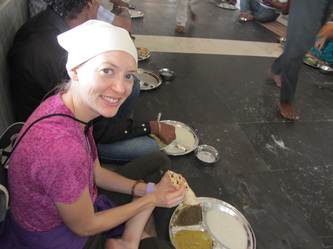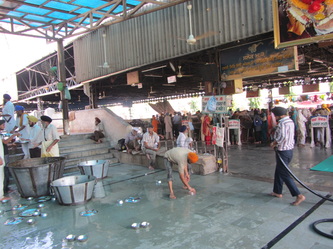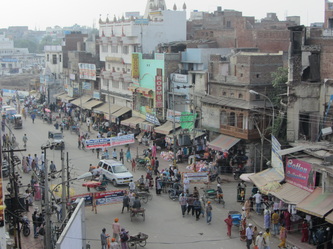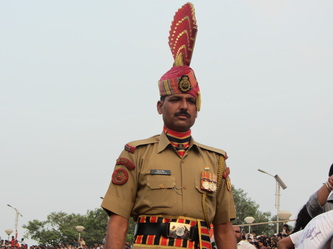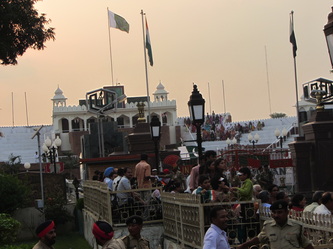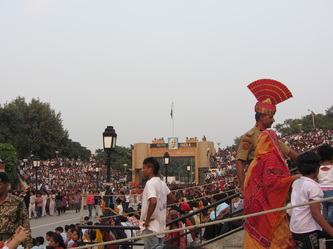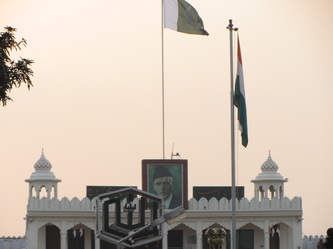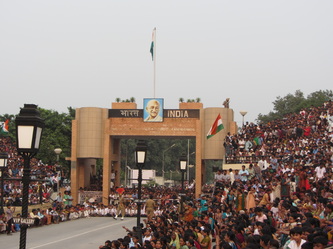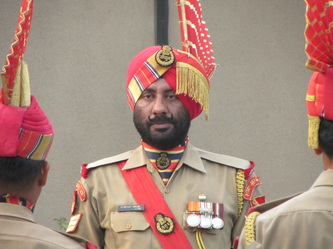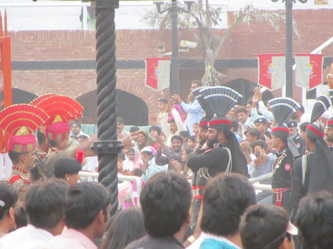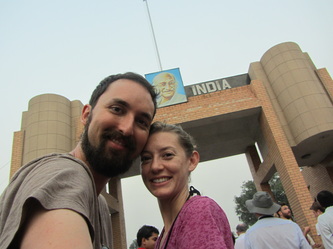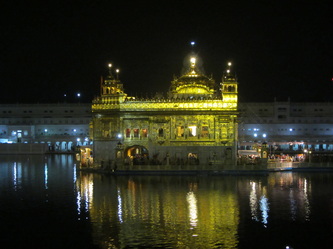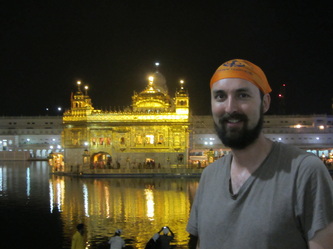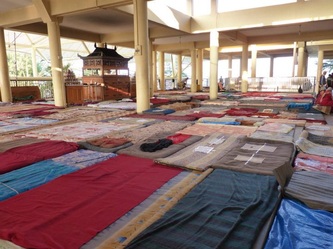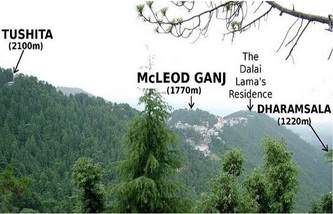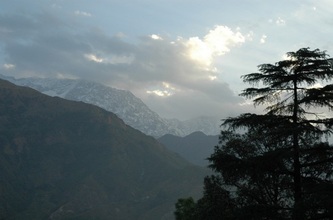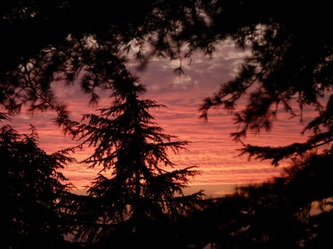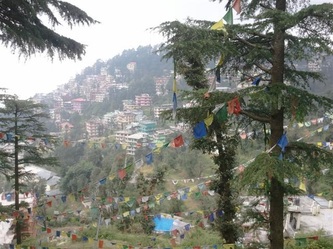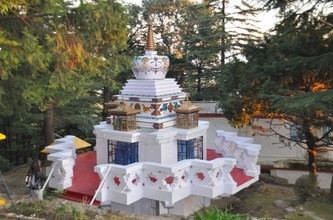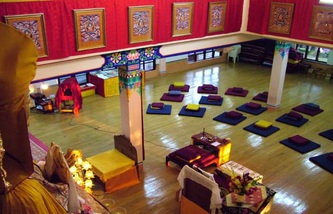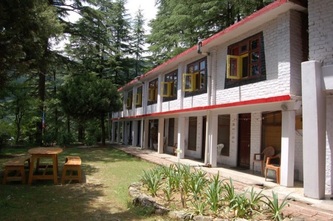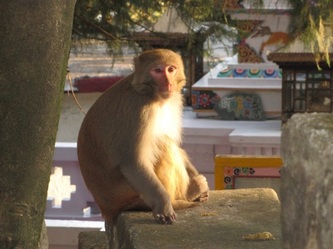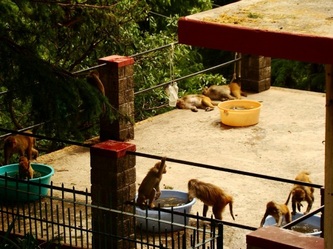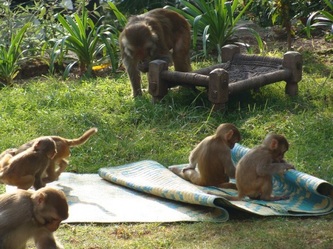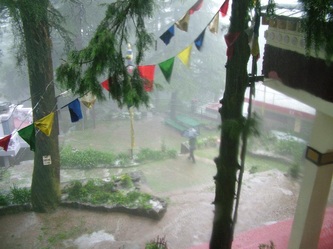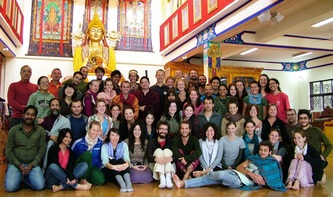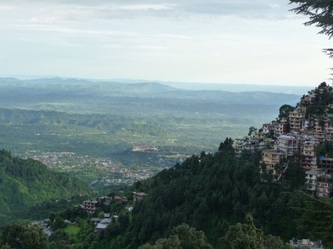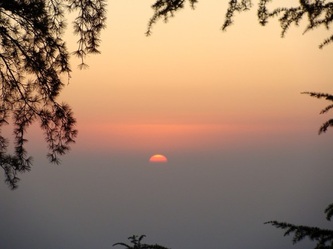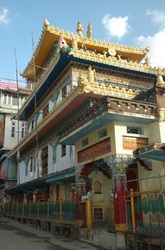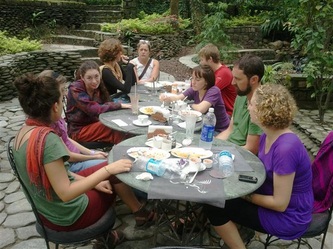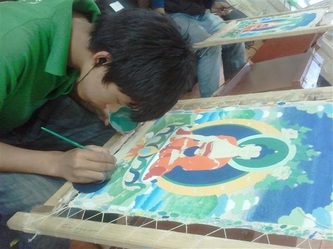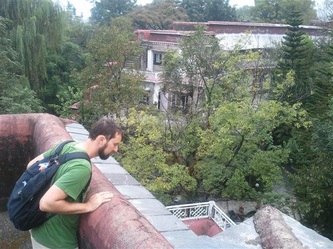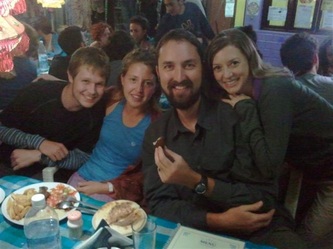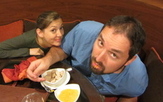We arrived back in Delhi, tired but sad to have the Indian adventure end. We took one last sightseeing trip to the famous Baha'i temple in Delhi called the Lotus Temple. We spent as much time as we could with Janis and Sophia, and even took a few more cooking lessons. Then, it was time to head back. The flight was bittersweet. We knew it had to end, but we still had so much to see and really started enjoying the Indian culture. We looked out the plane windows down on Delhi and it already felt like we were waking from an unbelievable dream. When we arrived at Houston International, Amy turned to Rob and said, "Did we really just spend two months in India? It feels like a dream." Rob responded by looking around and stating, "We must have, because it seems so clean here that I could lick the floor!" We shared a good laugh and walked back into our American lives.
Some final thoughts:
We pretty much ate vegetarian while in India. It was amazing how easy it was to find vegetarian food and how different it is from the Western notion of vegetarian cuisine (aka - iceburg lettuce on bread or tofu turkey). The dishes were so delicious and different, you would never know that it was meatless. Upon returning to The States, Amy has decided to continue with the vegetarian diet and Rob has returned to being, as he calls it, a "meatatarian." At least for now. One thing that helped them in their decision was something that was said at our Buddhism course. The teacher said, "Buddhism emphasizes compassionate living and this can be interpreted to mean many different things. If you want to be 100% compassionate, you'll get so extreme that you won't be able to eat anything or even leave your house out of concern for accidentally stepping on a bug. So, what's the answer? You need to find what you, personally, are comfortable with. Are you okay with eating meat? Great, do that. Are you okay with eating eggs, but no meat? Great, do that." This was a good lesson for us. Amy had been struggling for awhile trying to figure out what to eat. She has done a lot of research about the animal industry and factory farms and couldn't figure out what to do with the information and how far to let it affect her eating behavior. This little lesson helped us figure out that Rob likes eating meat, so he's okay with it. Amy would prefer not to, so she will choose other options. It's about making decisions that you will feel comfortable with, not trying to "do the right thing" or trying to change anyone or judge anybody for their choices. It's interesting to see a culture where around 40% of the population is vegetarian, and they all seem to be doing just fine. For Amy, it may well be true that we humans need to eat meat for maximum health, but she is okay with the possibility of shaving off a few years of her life in order to save possibly hundreds, if not thousands of animals. For Rob, it may well be true that humans need to avoid meat for maximum health, but he is okay with shaving off a few years of his life and slaughtering thousands of animals in order to consume their tasty flesh. At least for now. He'll probably go vegetarian someday, just not right now. The beauty is, we all have a choice, and there is no need to judge each other for it.
We were slightly terrified at the thought of dropping ourselves off in a foreign country with nothing but a couple of backpacks and a guidebook, but we were lucky to meet up with some very kind people who made our travels much easier. Even so, we want to encourage everyone to take an outlandish adventure, the thought of which scares the crap out of you. You don't need a safety net. Have faith in the people of the world to take care of you. Two years ago, we never would have pictured ourselves doing anything like this, but we heard enough stories of people going out on their own and relying on the kindness of strangers to make their travels possible, that we finally came to the conclusion that it can't be that hard. We think that a key thing for our India adventure was our willingness to accept the bad with the good, both of them being necessary ingredients for a worthwhile experience. Thank you to all of our friends who inspired us before this trip, the friends who supported us and encouraged us during the trip, and to all of our friends who have welcomed us back home. We love you all! You make us feel like the luckiest people in the world.
Love,
Rob and Amy
_We rode the train from Jodhpur to find a startlingly clean, small railway station at the end of the rail line in the desert town of Jaisalmer. Our pre-arranged driver from the hotel picked us up around 5 AM, and we rode down the sleepy street to our hotel on the edge of town. This town seemed a little different than the others – the road median had these stone pillars set out in an artistic, modern feel that was reminiscent of something you might find along a posh outdoor mall in Scottsdale. The fact that it was lit up by a near-full moon added to the glamour. We arrived at our hotel and were able to go immediately to our rooms and take a nap (for free! Don’t you wish more hotels offered that kind of service?). In the morning, we had breakfast on the rooftop and looked out over the desert town, and could see the old fort about 5 km away. This was Amy's final Lord of the Rings exclamation of the trip, "Helms Deep!". It was a massive stone fortress rising up out of a lone mesa, dwarfing everything else around it. Spreading out around the fort was the city of Jaisalmer, with nearly every building made of cut sandstone. The sand-colored buildings and low hills, combined with the wide blue sky, made us think of New Mexico, and we suddenly felt very much at home.
This being our last stop in India before returning to Delhi and catching our flight home, you’d think that we would have clamored to pack in as much adventure and sight-seeing as we could. At least, that’s what Rob was thinking before we arrived. But the fact that we had now been running ragged for nearly two weeks straight, combined with the desert feeling of home, made us decide to take it easy on this last stop. Besides, there were exactly two things to do in Jaisalmer: go on a camel safari and visit the fort.
We joined up with four Spaniards who were also staying at our hotel to go on the overnight camel safari. The driver from the hotel loaded all of us into his jeep, then took us to see a set of royal tombs of former Jaisalmer Maharajahs and their family members. Since they all cremated their loved ones, the tombs were actually cenotaphs (false graves) set up in memory of the dead. After that, we drove out of town for about an hour towards the Pakistan border. It was remarkable how similar the terrain was to New Mexico. And if our companions didn’t have that crazy Castilian lisp when they spoke Spanish, we could have sworn that we were in a version of New Mexico that had camels. We finally pulled off to the side of the road, where several camels and their caretakers were sitting. As soon as we started climbing out of the jeep, people were pulling at us to go hop on their camel, and Rob got totally confused. He wasn’t sure if these were the correct camels for the safari, so he resisted getting onto a camel. It was like we were being jostled around by a bunch of taxi drivers trying to get us into their vehicles, which should not have been necessary if we had a pre-arranged safari. But apparently they had the same instincts as taxi drivers, and they pulled us by the arms over to their camels, each of us hopping onto a camel saddle with the caretakers taking position alongside, reigns in hand. We leaned waaay back, and then the camel popped up hind-legs first, so we went from nearly horizontal to nearly vertical in half a second, then the front legs stood up and we had to pull ourselves back to sitting upright. The safari had begun! Now camel saddles are about as comfortable as a wooden box covered in a sheet, which is pretty much what they are. But at least you also get a big wooden handle to hold onto so you don’t fall off. And camels have this gait that forces your body to do this kind of forward-backward wave: your hips get pulled forward and your upper body tries to catch up, then your hips slow down and your upper body shoots past them. Once you settle into the groove, it’s actually kind of mesmerizing. But then your butt bones start hurting, and it’s time to take a break. So after an hour of sauntering through the desert, watching the camels of front of each us of fart and poop, we took a little break. We hopped off our big stinky friends and wandered over to a dune to take some pictures. Amy’s camel was apparently pretty exhausted by its burden, as it completely rolled onto its side and kicked its legs out to take a power nap. Amy and I went over to a little bush for a pee break, and two of the little boys who were leading camels kind of wandered over to get a good vantage point to watch Amy pee. However, she had her handy P-style with her, so she just turned her back to them and discreetly took care of business standing up. Of course, you have to give the P-style a little flick to get the dribble off the end of it. From the back, it looks like what a guy would do after he’s done peeing, so imagine the confusion of these boys as they debated whether or not she had some extra plumbing…
After another hour of riding, we came to the edge of the sand dunes and found our driver setting up some cots and a table for dinner. This was the end of the camel ride, and although we were expecting it to last quite a bit longer, our butt bones were thankful to be done with it. Dinner was simple but good, and we sat around the table as night fell, talking to our Spanish companions and the hotel driver. As the full moon came up, we started telling ghost stories (our contribution was the local New Mexico favorite of La Llorona) and talked about our impressions of India. The four Spaniards only had two weeks in India, and they were a bit freaked out by the whole thing. Understandable. It took us about a month to feel comfortable, and the first two weeks were definitely the roughest in terms of adjusting to everything; we could only imagine how crazy it would be to not have a local help you out with gently easing into life in India. We fell asleep on cots in the open desert, 30 km from Pakistan and under the bright full moon.
In the morning, we awoke to find an air-conditioned tour bus parked about 50 yards away from our camp. Seriously? There was an endless desert and they had to pull up right next to us? Right next to the tent toilet, too. Our camp watched as people piled out of the bus, then another bus pulled up next to it, and a small cargo truck. We quickly noticed that these were not tourists, though. There were three guys dressed in these Desperado-style cowboy costumes, a dozen or so girls in these police/cheerleader uniforms, and another half dozen dudes in black-and-white-striped prisoner uniforms. Then some guys pulled a boom out of the cargo truck and started attaching audio and video equipment to it, at which point we realized they were shooting some kind of video. So we all followed them up onto the dunes and watched these girls start line-dancing behind one of the Desperado guys, in sync with a Bollywood song! We watched, jaws dropped, as they shot a Bollywood music video right in front of our eyes. They had the classic formula: lots of fair-skinned foreign women in skimpy outfits dancing with a dashingly handsome Indian guy, with cheesy pop music blaring loudly. It was awesome. We watched for about half an hour as the women (who were obviously tourists that had no idea what they had signed up for) tried and failed to get the dance moves down before we hopped in the jeep and drove back to the hotel.
The rest of our time in Jaisalmer was spent exploring Jaisalmer Fort. We got some sweet pictures of the Fort and its bat inhabitants, but by this point, we had seen so many amazing stone structures that some of the awe was lost on us. We decided to spend half a day napping, then woke up the next day and spent our morning checking out the Jain temples inside the Fort. The Jain temple complex is a stunning set of intricately carved walls, columns, and doorways connecting seven temples in a close neighborhood. There were thousands of religious icons scattered throughout the seven temples, all of them variations on the marble shirtless dude sitting in a meditative pose. An overly helpful tour guide that we didn’t hire (but he followed us around anyways) explained that there were a series of Jain prophets/gods/teachers (it wasn’t really clear) that have appeared over the years, and the variations on the statues represent the different teachers. If you didn’t know ahead of time, you’d think they were all Buddha statues, but a quick way to tell the difference is that the Jain icons are never wearing a shirt, whereas Buddha always has robes on. At least, that’s what we found. Interestingly, there is actually a lot of similarity between the two religions in their respect for living beings, with Jains having a somewhat more restrictive diet and moral code. Although Jains represent a small minority in India, many restaurants cater to their super-vegetarian diet. They won’t eat anything that grows underground (potatoes, garlic, onions, etc.) because in order to harvest these crops, animals that live underground will inevitably be killed in the process. There’s way more to Jainism than its strict moral code, but we never got a chance to talk to a Jain about it, so that’s kind of the main thing we learned.
On our train ride out of Jaisalmer back to Gurgaon, we met a Chinese couple who had been touring India for a couple of weeks and were not impressed with the relatively narrow food choices available. In China, they said, you can get anything. In fact, the cities have no animals in them because they all get eaten. Birds, mammals, reptiles, amphibians... everything. If it moves, it gets eaten. With that kind of selection, it makes sense why someone would be disappointed in the variety of Indian foods!
When we finally arrived at Janis' house, we received an odd text message from our travel agent: "Found your iPod at the hotel. They can send it to Janis via courier." We were a little confused by this, as we had our iPod in our backpack. We thought. Upon checking, we realized we didn't have our bag of electronics, so we were missing the iPod, a camera battery, battery charger, some cables, and the camera memory card that had pictures from Bangalore all the way up until Rob changed the cards out in Amritsar. So everything except the last two weeks was missing. After panicking for a few hours, and several phone calls later, we found out that they found the iPod at the hotel after we had left, but there was no trace of anything else. They even checked the garbage for us, in case our electronics bag somehow ended up in the trash can. But all to no avail. Our memory card and pictures were lost forever, probably on the train ride back to Gurgaon somehow. It was a sad way to lose the pictures, but we were heartened by the fact that the hotel alerted us to our missing iPod. They ended up sending it to our travel agent in Delhi by way of another pair of American travelers (because the mail system is so untrustworthy), and we arranged to have Janis mail it to us in the U.S. when she flies back the States for Christmas (again, because international mail has a decreased chance of making it to its destination when the contents have anything of value). Ah, the joys of traveling!
After Jaipur, we headed out to our next stop - the Blue City of Jodhpur. This city was once called Marwar, meaning "region of desert," but due to some translation and pronunciation issues back in the day, it somehow changed to mean "region of death." Ah, wonderful. Now we're REALLY going to sweat to death. The city is blue for several reasons. First, the Brahmin caste used to paint their houses blue to signify their status, but soon others followed suit, so there were more and more blue buildings. Second, the color blue helps the houses stay cooler. Lastly, blue apparently repels mosquitoes. Whatever the reason, it's freakin' awesome.
Jodhpur was one of our favorites. First, they have a fort called the Mehrangarh Fort which we feel was even more impressive than Amber Fort in Jaipur. Again, Amy exclaimed, "Helms Deep!" You could just imagine soldiers poised on the walls watching as an advancing army draws closer and closer. Man, times were rough. The fort was a maze of floors, courtyards, and rooms. Good thing they give you a map at the entrance! On one of the floors, we walked past a sign that said something about a music organization. This man came out and asked if we wanted to hear a little free traditional India music. We walked in, sat down, and he started to play the sitar. It was incredible, we felt transported to a different time and place. Afterward we got to talking, since Amy is a musician and had lots of questions. It turned out that he had started this organization to preserve traditional India music and there was a very famous sitar player coming to the fort that evening to give a private concert. The man invited us to come as special guests. He also asked if Amy would be willing to perform at a school in town for blind children where he does music therapy. Amy was very excited, but unfortunately, we couldn't get it arranged with the school in time, since we were only in town a few days.
We finished the tour of the fort, left and wondered around the city awhile, then made our way back to the fort that evening for the concert. It was held out on one of the larger balconies on the top of the fort. It was very elegant, with a white canopy, dimmed lights, and covered chairs. We sat down and waited for the show to begin. It turns out that the performer was none other than Ravi Shankar, a musical legend in India. Amy about lost it. As he played, the people around us would sing along and nod in approval of Mr. Shankar's intricate improvisations. Amy just closed her eyes, let the music fill the open space, felt the wind brush lightly across her face, and took in the sweet night air. It was enough to bring tears to her eyes. After the concert, it happened that there was some sort of religious celebration down in town and they started lighting fireworks. We stood at the balcony wall, left in awe of the evening's music and looked out at the city lights and the brilliant fireworks filling the sky. Incredible is an understatement. That was probably our best night out of the whole trip.
The next day, we heard about a festival going on called the Marwar Festival. It only runs only one weekend a year, and we just so happened to be there that weekend. The lady at our hotel had tickets, so we headed over. It was a bit strange. Picture a small football stadium at a local high school with covered bleachers. That wasn't the strange part. It was that there were only about 100-200 people there, instead of the 1000s we had grown used to. It was a welcome break! The festival was similar to a state fair, with competitions and presentations during the day, and a big show right before dusk. We arrived just in time for the "Beard Competition" where men lined up on stage and sported their facial creations. That was entertaining! Next came the "Turban Tying Competition" where men had one minute to tie a turban and they were judged on style. These men looked like they were in fast-forward! We've never seen anything quite like it. Rob had been wanting to learn how to tie a turban, so he was paying special attention, trying to figure out their technique. After they announced the winner, they then said that up next was the turban-tying competition for the foreigners and invited any foreigners on stage to give it a try. Rob looked at me and said, "Hell ya!" and ran up on stage. The tourists had five minutes to complete their turban and it was hilarious watching them try to figure it out. There were about 8 of them, a few Americans, a few Australians, some Israelis, a French girl...and all of them looked like they were wrapping bandages on their heads! Amy laughed and cheered Rob on from the bleachers. She was shocked to see that Rob's turban looked really good, especially for it being his first time tying a turban. I guess he really did pay attention when the experts were going! The judges debated and a little while later, announced the winners. Third place, this guy from Australia. Second place, the French lady. First place, Rob from the Unites States! Holy cow!! Rob won a freakin' turban-tying competition in India! He even got a trophy. We scratched our heads thinking, "We're traveling with backpacks! How are we going to get this trophy home?" It didn't matter though, we must figure it out. I told Rob he needs to put on his resume that he is an international turban-tying champion. How could anyone say no to that??
The last highlight in Jodhpur was that right across from the festival stadium was a small mall with a brand new movie theater in it. This was our chance to finally see a movie in India! There weren't any American movies playing, so we decided to go with the movie called "Rascals" in Hindi. The chairs were super comfy, the screen was big and the sound was good. Much different than our theater experience in the Philippines back when Rob was on deployment! The movie was a comic-action flick, so even though we didn't understand what they were saying, it was pretty easy to figure out what was going on. Our two favorite things about Bollywood movies: #1 - they break out in a mini-music video every 30 minutes or so. This is not your average scene, where something intense happens, an actor looks up tortured in thought, and does the only thing that any of us would do for a 2 million dollar movie deal - breaks out into song. No, these Bollywood movies don't need an excuse to get everyone singing and dancing. And the scene for the mini music video doesn't even have to be related to the story really at all. It was awesome. We were laughing and looking at each other like, "Is this for real?" #2 - they have intermissions! Halfway through the movie, the lights came on and everyone left. Time to hit the concession stands and use the facilities. It was only about 10 minutes, and people were used to the drill, because they quickly returned, arms full of soda, popcorn, samosas, and candy. This is about the time we swore that we would study up on our Bollywood knowledge once we got to Ohio and definitely have a Bollywood night. Ah, India, you are one of a kind!
We were only in Jodhpur for a few days, but had a blast. At this point, reality really started to sink in. We only had two more stops before we had to fly back to the The States - Jaisalmer and Delhi. Our trip was almost over. And we were not ready to leave! We had finally acclimated, really starting enjoying all the quirkiness of India, and now it was almost time to go. Two months. Two months? Has it really been that long? It seemed like such a long time when we were planning this trip, but now it's come and gone. Well, I guess we'll add India to the list of places we must go back to in the future. But, it's not over just yet...we have a few more memories to make. On to Jaisalmer!
During our Jaipur visit, we spent half a day at Amber Fort, which is on the out skirts of the city. If we didn't already think we were going to sweat to death, this place made a feel like we were literally in a 400 degree oven. It amazed us to think that people lived out here once upon a time!
So, Amber Fort. Our first Indian fort experience. This place was absolutely incredible! It is a fort and palace built in the 1500s by a lake called Maota Lake. It sits upon a hill out in the Indian plains and definitely makes a statement. Such as, "You don't want to mess with this." Or, "Ha, ha, good luck get through these walls." When we laid our eyes upon it, it was the first of several references Amy kept making to Lord of the Rings. "It's like Helms Deep!!" she would exclaim. Yeah, embarrassing American tourists, that's us!
The pictures do a better job of describing it. There are other forts and buildings in the area, but we were hot, sweaty, thirsty, hungry...so we said, "Cool. Let's head back to the shade!" Back to Jaipur...
Jaipur is part of a Royal Triangle Tour or something, where short-term visitors hop from Delhi to Agra to Jaipur, then back to Delhi and home. So it's a bit touristy, but nothing like Agra. It's called "The Pink City" because back in the day, one of the Mogul emperors who ran the town decided to have all the city walls painted pink. That's all in the older part of Jaipur now, inside the old city walls. But that's where all the main tourist shops and bazaars are held, so everyone gets to see the pink when they come to town. Our new friend Janis insisted that we stay at her favorite guesthouse, a European-style hotel called Arya Niwas. They had absolutely delicious Western food there. Ice cream, desserts... it was a nice little break in our Indian food adventures. She also referred us to an Ayurvedic massage clinic that she always goes to when she is in town. Curiously, Ayurvedic massage is most famously performed in the Southern state of Kerala, but these guys beat the pants off the masseuses down South. Of course, they were also from Kerala, so I guess they just moved up North to Jaipur to make more money. But they were very good. Amy and I both got slathered in scented oils and had full body massages on our second day in Jaipur.
Before we even got into town, Amy saw that there was an Astrological Institute in town, so she decided to get her star chart drawn up. These are very important in India, and are usually done right after a baby is born so that the parents can plan for their child's marriage. After all, it's tough to find someone to marry your kid if you have no idea who they're compatible with in marriage, how many kids they're gonna have, and all that stuff. As it turns out, Amy was checking a Tibetan astrology book while we were browsing the Tushita library back in McLeod Ganj, and we are one step better than mortal enemies. Compatibility score of -3 on a scale of -4 to +4. So no one's really sure why she was pursuing this astrology stuff after that, but Rob wasn't really going to argue. He didn't want to push us any further down on that scale... So we found the Indian astrology dude, who apparently has lots of degrees and awards for both his astrological talent as well as his palm reading skills. We ordered up the deluxe package for Amy, gave him her exact time of birth and location, and agreed to come back the next day for the results. Now Amy will tell you that the guy guessed a lot of things about her that he could not have possibly known, but Rob is pretty sure he heard some information being passed in conversation before the guy gave his predictions and palm reading. In any case, there were a few things he mentioned that were shockingly detailed and came out of nowhere, so Rob wasn't quite sure what to think about it. The astrologer did mention, however, that Amy is going to be Rob's sugar momma, so that was encouraging. But he also told her when she could expect to fight for her life and most likely die, so that was less encouraging. You take the good with the bad, I guess.
After that, we went to this corner of town that is close to the royal palace, where there is an astronomy park unlike anything we had ever seen. Hundreds of years ago, one of the rulers of Jaipur became very interested in astronomy, and contracted some of his subjects to go to Europe to study astronomy, then come back to teach him. They did that, and the result was that he ended up building astronomical measuring instruments out of stone and metal -- a giant observatory. The park is called "Jantar Mantar," which means something like "measuring instrument." They had a gargantuan sun dial that had a precision of 2 seconds, and they knew how to correct the reading for local solar time. Our tour guide was phenomenal here, and we learned that their obsession with astronomy was directly related to having a precise time measurement tool so that they could have more precise astrological charts for people. This was Rob's first exposure to the historical intersection of astrology and astronomy, and he was blown away by the mathematical precision of astrology. It was a really cool experience!
_For Rob’s birthday, we hopped on a bus, another bus, and then a train to go to Amritsar, which is a big tourist destination in the Northwestern state of Punjab. Punjab is famous for having some of the best (and most recognizable to an American) North Indian food, such as Tandoori chicken. The two things to see in Amritsar are the Golden Temple and the Pakistan-India border closing ceremony. And that’s about it. We arrived in the evening to a lovely old estate house that was converted to a guest house, and ran into a group of Australians having a late dinner on the patio. It turns out that one of the ladies was married to a submarine commander in the Royal Australian Navy. He served back in WWII, and then later somehow ended up becoming buddy-buddy with the Dalai Lama, so she goes to visit McLeod Ganj every few years to help with the hospital up there and say hello to His Holiness. She had quite an amazing story, and we had hoped to visit with her more, but unfortunately we missed seeing them again. People tend to only stick around in Amritsar for the minimum number of days necessary.
The next morning, we woke up and packed up our little bags to go see the famous Golden Temple. This place is huge, magnificent, and is the holiest site for the Sikh religion. The Golden Temple is actually a smallish shrine two stories high, with its walls completely covered in glimmering gold paint. I have no idea how much of it is made of actual gold. But it looks pretty amazing. It’s surrounded by a marble pool, with a marble bridge leading to the entrance over the water. Most of the people in line to go into the Golden Temple were carrying some kind of a syrup-covered cake thing in as an offering, and as far as we could tell they just bought it at a window, and then carried it over the bridge to dump it into a garbage bin at the front door of the Golden Temple. It looked very gooey. The water is reputed to have healing powers, so we dipped our feet in it, just in case. Surrounding the pool is a wide marble walkway, which is in turn surrounded by a large white wall with various buildings and towers thrown in. They must have millions of visitors each year, because we saw thousands and thousands of people milling around, and this place is open 24 hours a day, 7 days a week. One cool thing we did was to visit their free community kitchen (you just drop in a donation as you can afford, but it’s not required). They have these large halls with rows of burlap fabric laid out for you sit down on, cross-legged. You bring in a plate, a bowl, a mug, and a spoon, and then you sit down and wait for these guys to stroll down each aisle and pour you some soup or curd or tea, and they give you a chapathi (kind of a mini-tortilla) and some vegetables and lentils. For being able to serve something like 100,000 people a day, it actually tasted pretty decent. On our way out, we saw some of the enormous pots they cook the soups in, as well as the massive assembly line of volunteers cleaning the plates, bowls, and utensils. We were told that it’s considered a sacred duty to volunteer at this kitchen, and that many of the volunteers spending their time helping out were children of very wealthy people in the city. The Sikhs are very proud of their ability to take care of their neighbors.
What’s more, we saw many paintings of their religious leaders refusing to meet with Mogul emperors until the emperors sat on the ground and ate with the common people during lunch. They don’t think anyone is above anybody else in the eyes of God. That was pretty cool to see. What was not as cool to see were the other paintings in the museum at the Golden Temple. The Sikhs were persecuted pretty severely by some of the Mogul emperors because they absolutely refused to convert to Islam. They trace their religious lineage back to their first teacher who showed up around 700 or 800 years ago, and somewhere along the way, they incorporated a very strong warrior ethos into the religion. So when the Moguls came along, they gave them quite a fight. The paintings we saw were of Sikh martyrs being flayed, boiled alive, stoned to death, and fun stuff like that. But those weren’t even the disturbing ones. Apparently the Mogul invaders made a sport of cutting up infants into small pieces, making a garland out of them, and then hanging this around the necks of their mothers while they killed their fathers. So with this kind of historical imagery, it started to dawn on us that they probably didn’t like Pakistan too much, being a Muslim state and all. And sure enough, at the end of the museum tour, there was a display case of artillery shells, rifles, and commemorative knives that celebrated the contributions of the Sikhs during the Indo-Pakistan war. There’s some deep-seated rivalry there.
After the Golden Temple, we strolled over to Jallianwalla Bagh, which is the site of a massacre in 1919 that precipitated the eventual overthrow of British rule in India. There was a group of protesters gathered in a park area in between some apartment buildings, and there were only a few entrances and exits to this place, so when a squad of British soldiers went in to disperse the protesters, there was no way for the people to quickly escape. They opened fire on the protesters, and it was just a bloodbath. Dozens of people jumped into a nearby well to escape the shooters, and they were crushed to death by dozens more jumping in on top of them. You can still see many bulletholes in the building walls, so it’s a pretty somber sight. We were looking at a bullet-ridden wall, contemplating the tragedy of the place, when all of a sudden, SMACK! Rob got a nice big piece of syrupy offering cake thrown perfectly into his forehead. We weren’t quite sure what to make of it, since we had no idea where it came from, and nobody yelled anything at us, so we just kind of wandered over to the washroom and washed it off. So that was weird. Happy Birthday to Rob!
Later in the day, we found someone to give us a ride to the border-closing ceremony. It was very shady - basically the operator sold more tickets than he had seats for in his vehicles. It was quite an ordeal, but we ended up getting in a vehicle, in a very cramped seating arrangement, and arrived at the border just before the ceremony started.
When we arrived, there were, as always, SO many people!! People and buses and cars...with lots of shouting, gasoline fumes, dirt, trash...it was overwhelming. We walked about half a mile to reach the ceremony site, which was a stadium. It was packed to the gills, with people even hanging off the stairs to get a good look. We felt defeated. All that work to get here, and we weren't going to see a dang thing. Then, Amy spotted some other "whities" walking around back, so we decided to follow them. They joined a short line of people going through metal detectors, and showing ids and special-looking papers to officials - like a VIP line. Rob said, "We don't have VIP access." Amy at this point had accepted that nothing in India is as it seems and said, "Let's just try. What's the worst that could happen? We get kicked out?" Rob thought for a minute, shrugged and said, "Cool." We walked as inconspicuously as possible through the detectors and when we reached the officials, they just looked at us and waved us through. We then were escorted to a set of bleachers right up by the actual gates distinguishing the India and Pakistan border, and sat us down with about 50 other pale faces. We saw a small sign saying "Tourist seating." Tourist seating?? We're so glad they advertised it! Geesh. At least we decided to be risky and join the line! Now we had primo seats - with an up close, clear view. Amazing!
The ceremony itself was unlike anything we had ever seen. Somehow, the guards on the India side and the Pakistan side made a collaborative effort in creating costumes and a very entertaining border-closing ceremony. The border closes everyday at sunset and these guards do a whole production - they don't just close the gates. It was incredibly entertaining and pretty cool to say that we literally saw Pakistan. The pictures will do a better job of setting the scene and describing it.
The driver actually waited for us, and we got a ride back into town. We had dinner with some Israelis we met on the ride, then headed back to the Golden Temple to get a view of it at night.
It was a fun, albeit short trip. Just two days in town and we were off to our next destination - Jaipur.
_After the Buddhism course let out, we had a couple of days to hang out in McLeod Ganj before the Dalai Lama was scheduled to give a four-day teaching. Our classmates voted to meet up at a bar in the neighboring town of Bhagsu the day after the course finished, so that’s where we went after spending a day readjusting to the noise and clamor of real life outside a meditation center. It’s surprising how much of a shock to the senses even a laid-back town like McLeod Ganj can be when you’ve just spent ten days in near solitude. So going to the party town of Bhagsu was even more of a shock.
Bhagsu is where all the Israeli tourists stayed, because somehow this little mountain town got the honor of being put on their popular travel circuit. Many of the local merchants have embraced it, and now about half of the signs on the main drag are written in Hebrew, while the restaurants serve the familiar comforts of home such as hummus and pita bread. Several of the bars have seized on the young rebellious crowd that rolls through town, so Bob Marley is playing in many of the bars, and the wall decorations are often strange blends of Jamaican colors, Hindu and Buddhist symbols, and the occasional alien and/or pot leaf thrown in. It makes you feel like you are definitely not in any of those locales, and you can just kind of pick what you want the place to be. So we settled down for some hummus, curry, and Indian beer, and tried to talk to our new friends through all the reggae music and pot smoke.
One of our new friends insisted that we try the local dessert, called Bhagsu cake. Rob had been fiending for some chocolate cake since about day 3 of the Buddhism course, since the instructors loved to use chocolate cake as an example when they talked about attachment and happiness. Unfortunately, as a general rule, baked goods in India are terrible. So when we tried some chocolate cake at our hotel on our first day after class, the result was epic failure. We were dubious about the Bhagsu cake, but our friends were insistent, so we tried a piece when they brought a box of it to our table. Epic Win! As far as we could tell, the cake (which is actually more of a Midwest-style “bar”) was built from a layer of crushed Parle-G gluco-biscuits (they’re kind of like a British butter cookie or something), followed by a layer of toffee-caramel deliciousness, and then a layer of hardened chocolate. Awesome! The best part was that this gourmet delicacy came from a little corner store, kind of like an Indian 7-11 or Quickie Mart. We love Bhagsu cake!!!
A few days later, we signed up for the Dalai Lama’s four-day teaching, and apparently there is a certain etiquette to saving seats at the main temple. You go there a day or two before the event starts, and you put down a mat or tape down a piece of cardboard where you are going to sit. But you can’t just sit anywhere. There are whole sections roped off for the sponsors, which in this case was a massive group of Taiwanese who had flown to India to hear the Dalai Lama speak. I’m sure that pissed off the Chinese quite a bit, seeing as how they consider both Tibet and Taiwan to be part of China, and the Dalai Lama is a hated enemy of the Chinese government. But anyways, we showed up two days before the teaching and found some extra mats laying in a pile, so we put one down in the English translation section and taped our names written on cardboard onto the mat.
On the big day, we woke up extra early and went to the main temple around 6:30 to get in line. Of course, there was also a big cow standing in line for no particular reason, except perhaps because the line stretched out onto the road in front of the temple, and cows enjoy being on the roads. It turns out that we got there well before the security guards did, so the line didn’t start moving for about 45 minutes. And then we learned that it’s nice to be a guy at these events, since they broke the line up by gender (due to guards having to frisk everyone), and there were way fewer men than ladies at the teaching. Yeah, women rock! So once they opened the lines up, Rob grabbed both backpacks and went up to the front of the line to go through the male entrance, whereupon he encountered the most comprehensive security we’ve ever seen at a public event (presumably out of fear of the Chinese government trying to assassinate the Dalai Lama). After going through a metal detector, you had to go to a guard waiting to frisk you. After he checked you over and had you empty your pockets, he would go through your jacket, jacket pockets and liner, and then check your bag. After your bag got searched, he would search inside everything inside your bag, so they unscrewed pens, opened radio battery compartments and verified the radios worked, etc. We were very impressed. This also explained why everyone urged us to get in line early, since it took several hours to search the 4,000 or so attendees. Once we got inside, we found our mats and broke out some biscuits (crackers, actually) and peanut butter for breakfast. The Dalai Lama’s main temple complex has a courtyard area with stairs going up one side into an open-air seating area (consisting of bare floors). In the middle of this upper seating area, there are two sanctuary-like inner temples with a walking path around them. The Dalai Lama sits on a big chair in one of them when he gives his teachings, while all the listeners outside of the inner temples have to wear headphones connected to a small personal radio. They also had several large TV screens set up so that everyone could see him talking.
Before the teachings started, some monkeys noticed us sitting near the edge of the upper seating area with our tasty treats. One of them climbed onto a nearby tree branch right behind Rob, so he turned around and tried to shoo him away. Well, the monkey wasn’t too impressed, so he jumped onto the railing that Rob was leaning against, reached through, and then slapped Rob on the arm before jumping back into the tree! He got monkey slapped!!! So Rob stood up, turned around, and started growling at him to scare him off. This just seemed to piss off the monkey even more, as he bared his teeth and started to growl back. Luckily, one of our friends handed Rob an umbrella with a metal pointy end before things escalated any further, and this seemed to trigger a memory in the monkey. As soon as he saw Rob with the long pointy umbrella, he leapt down the tree, onto the roof of a nearby building, and quickly scampered out of sight. Little bastard! Rob’s arm was slightly bleeding from the monkey slap, so he rubbed some Purell into it and hoped that he wouldn’t get rabies.
After that flash of anger and attempted violence, we all settled back down for the Dalai Lama to show up. "Ommmmmmmm." We were sittting about fifty feet back from the walkway he used to enter and exit the inner temple, and we had a terrific view through the temple windows to see the chair he would be sitting upon. When we finally got to see him, he was ambling along the walkway, grinning like a kid, greeting the crowd. And once he started talking, he smiled and laughed for a good hour while he gave some introductory remarks on Buddhism in relation to the rest of the world. It was pretty uplifting to see someone who was so genuinely happy. Since the sponsors of the teaching were Taiwanese, the Dalai Lama spoke in Tibetan for several minutes, then paused while several translators spoke into their respective radio transmitters -- you could tune in anywhere in town to hear His Holiness in Tibetan and the translators in English, Chinese, Spanish, or German, depending on what radio frequency you dialed in. A group of us from the Tushita course all sat together, and we were pretty pumped because we actually understood a good chunk of what he was talking about. With no previous training, it would have gone right over our heads. We were told that most of the people who attend the teachings have no idea what he’s talking about once he gets past the introductory remarks, but that people enjoy simply being in the same place as the Dalai Lama. Now we understand why. He’s a very unique person, and he seems to radiate peace and happiness. With him starting to get so old, we were worried that this might be our last chance to see him, but apparently he has decided to keep on until he turns 90, at which point he will re-visit the question of whether to step down or not. Rumor has it that if he lives out his natural life, he’ll live to be 114. So don’t despair! You can still book a trip to Dharamsala and see him teach in person for many more years.
We stuck around for the afternoon session of the teaching, and then decided to forgo the remaining three days. It is extremely hard to pay attention to what’s going on when he talks in Tibetan for ten minutes straight, then you get a five minute translation, followed by another ten minutes of Tibetan. Your mind starts to wander, and you kind of lose track of what he was talking about. Given that the topic was “emptiness,” it wasn’t exactly a simple lecture. So on the remaining days, we decided to explore around the mountains near McLeod Ganj. We decided to hit up the clinic near our hotel to just check on Rob’s rabies, and that was quite interesting. It turns out that it was a Tibetan herbal medicine clinic, not a Western medical clinic, but we figured the doctors would know if we should go to the hospital 8 km down the road. Rob showed the doctor his monkey scratch, and she didn’t seem too concerned about the rabies part. Instead, she prescribed a set of 5 Tibetan herbal pills that would “help eliminate any poisons in the blood.” Well, that wasn’t exactly what we were worried about, but we figured she would know if Rob was beyond her help or in danger in any way. After all, there were a lot of monkeys in these parts. “So how often do I take these pills?” he asked her. “Take one today, another one a week from now, and then one every full moon until you run out.” Ooookay. It was only about three dollars for the visit and the pills, so we decided to go ahead and give it a try. If Rob started having any rabies symptoms (not that we knew what any of them are), we would go to the hospital. Not our smartest moment, but apparently it worked out okay, since Rob didn’t get rabies. We encountered a friend of ours from the Tushita course at the clinic on our way out, and she was seeing the doctor for a nasty infection that was spreading up her foot from an open laceration on her foot. Her sandals weren’t doing a terribly good job of keeping out the dirt and feces from the road, so I wasn’t surprised to see it getting so infected. We told her good luck, and then made our way up the mountain road to go on a nice hike in the Himalayas.
It’s amazing how the weather changes up there at cloud level. You don’t really see any clouds above you when it starts to get cloudy, so much as clouds coming right at you. That’s when it’s time to get the hell off the trail and find some shelter. So we tried to do that when it started getting rain-cloudy, but we soon found ourselves quite a ways away from either of two towns that we were in between. Fearing a flash flood coming down the rocky mountain trail we were following, we booked it down to the village of Upper Dharamkot. We lucked out and avoided getting drenched, but as we followed a stone staircase down the side of the mountain valley, Amy spaced out for a minute and lost her footing, then fall face-down onto the stairs and prickly weeds below her. Lucky yet again, she just tore up her knee and got some nasty pricks on her arm without breaking any bones. We busted out our dinky little bag of band-aids and tried to stem the bleeding, and then she limped the rest of the way down the hillside back to our hotel. The path we took went down through Bhagsu, so of course, we had to stop to eat some more Bhagsu cake to lift our broken spirits. It was a rough day.
Later that night, the Tushita group was meeting up again, so after Amy rested awhile at the hotel, we made our way back out. It now took us twice as long to go anywhere because Amy couldn't bend her knee or put much weight on it. At the bar/restaurant/club (the place we met up was incredibly confusing - fancy tables for dining, with a huge dance floor and bar, and blaring hip hop music, with all the lights on - it was just weird enough to not work at all), we saw our friend from earlier, with the foot infection, and it had already started healing and all the redness was gone. Guess the Tibetan medicine worked for her, so we felt a lot more confident that Rob wouldn't end up like one of those creatures in "I Am Legend".
Then it was already time for us to head out to the next city on our list. We really loved our experience here and would definitely come back again. When people ask what the best part of our trip was, we have to say it was the Buddhist course, Dalai Lama teachings, and the city of McLeod Ganj.
Our next stop...Amritsar! Home of the Sikhs.
__We took an autorickshaw up to Tushita Meditation Centre from McLeod Ganj’s main square, since we would have had to carry our enormously heavy backpacks (despite leaving a bunch of crap at Janis’ house) up a steep mountain path. We opted to save our backs for the punishment of sitting in meditation. When we got up there, we turned in our money and wallets, books, and all electronic devices (basically anything that might tempt us with distraction). This was all locked away in a big metal safe for the duration of the camp. We mingled with the crowd a little bit and had some tea while everyone was getting registered, and Rob got put in the dorm with all the self-confessed snorers.
After settling into our rooms, we went down to the main “gompa” (meditation hall) and met our caretakers for the course. We had a German nun coordinating the course, an Australian instructor giving the teachings, and a monk from California leading the guided meditations. Quite the global perspective. After going through the rules and schedule for the duration of the camp, we got out and were allowed to go down the street for one last bit of contact with the outside world at a chai shop. Basically, the German nun wanted to make sure everyone was fully stocked with chocolates and biscuits. After that, it was no talking and no leaving the premises. And no killing anything, including spiders and mosquitoes. And no killing the monkeys. But we’ll get to that later.
We awoke each day to someone ringing a small gong at 6 AM, which is a surprisingly gentle way to wake up. Although there was one Western toilet in the shower and toilet complex near Rob’s dorm room, he caved and finally learned to use the Indian style toilet out of fear of spiders or other little beasties living on the underside of the Western toilet. He never did give the “hand-wash-the-bottom” thing a try, so he ended up carrying toilet paper with him. After brushing teeth and having a cup of tea, or in Rob's case, instant coffee (they didn’t provide any coffee, so Rob was thankful that he bought a jar of decent instant coffee in Gurgaon at Easy Day/Wal-Mart), everyone followed the gong to the gompa at 6:45 for guided meditation. We did this for 45 minutes, then broke for breakfast. Rob pulled breakfast dishwashing for Karma Yoga duty (Karma Yoga can be thought of as either selfless duty for others or as a euphemism for chores), so he had to finish breakfast a little faster and throw on an apron to join 4 teammates and slog through plates, bowls, mugs, and silverware for the 66 students in our class. They didn’t quite finish their task on the first day, but they got the hang of it by day 2 and finished within about 45 minutes. After that, we had two sessions of classroom instruction in the gompa, then some light stretching/yoga followed by lunch, an hour or so to relax and read, and then Karma Yoga time (sweeping, toilet cleaning, window cleaning, etc.). Amy pulled toilet cleaning duty, which sounds like a bum deal, but she was somewhat thankful in that she could ensure that the showers and toilets were clean for her own use, especially after using the dirty bathrooms at Yoga Camp in Mumbai. It was also probably one of the quickest Karma Yoga jobs because Amy was on a team of 4 to clean 3 toilets, 3 showers, and a trough (aka - sink). Indian toilets are very easy to clean because you basically just douse the whole stall in Clorox. The worst job was emptying the toilet paper bins (no TP can go down the toilets due to ancient plumbing lines getting clogged). Gross on that account. By the end, Amy's team was enjoying their little afternoon meeting and were actually a little sad when it was over. It was kind of strange, because at the end of it all, everyone thought their own Karma Yoga duty was the best assignment, and they felt really bad for somebody else (typically the dishwashers or the toilet cleaners). But the toilet cleaners finished their job within about 20 minutes, and the dishwashers got to relax during regular Karma Yoga time because they had to do their duty around mealtimes. So it all worked out pretty good.
In the afternoons, we had an hour of discussion in small groups. This was our one period of time in which we could talk (other than asking a question during lectures), so of course everyone kept talking way past the time that the gong rang to signal our end of discussion period. It was hard to cut off the interesting conversation with our new friends. Amy and Rob were in different discussion groups, so we actually didn’t talk to each other (except the very occasional quick whisper) for the whole ten days. The discussion groups were great, though, because that’s where we got to understand what other people were bringing to the table when they looked at Buddhism. Some people had terrible tempers and wanted to find a way to calm down, others were simply curious about this unique approach to life, and a few of us had learned about Buddhism before, but had completely incoherent and misguided ideas about it. After discussion group, we had tea time, and then a lecture period followed by a guided meditation. After that was dinner, another guided meditation, and then around 8:30 we were free for the rest of the night to do self-study. With all the free time to sit and think and wander around the lawns, we ended up borrowing and reading several books from the on-site library over the length of the course.
One strange aspect of this whole thing was the fact that there were 66 of us, all sitting together and eating together and working alongside each other, but no talking outside of our small discussion groups. The first few days, everyone kind of awkwardly smiled and waved as we passed each other. Nobody was quite sure what the social etiquette was, when there was no talking allowed. Do you smile and nod a “hello”? Give a little hand wave? Do you look at the ground and just kind of ignore everyone? Or is it something in between? Rob took advantage of the awkwardness and gave little waves to Amy throughout the day, trying to get her to crack up and smile. But after a while, we both realized that the point was not to simply stop talking, but to stop looking outward at all, and to focus on our own internal experiences. After a few days, most people were comfortable with walking in silence and not trying to communicate using hand signals. Yet somehow, by the end we all felt like we knew each other because of our shared experience. It was a very unique bond.
Another strange part of the experience was realizing how many Israelis were in our class. As it turns out, there is a very large number of Israeli men and women who finish up their obligated tour of duty in the military (2 years for women, 3 years for men) and then go on an extended international trip before taking the next step in their professional lives. There seems to be a well-known travel circuit in North India that is very popular with these young Israelis, and nearly every one of them that we talked to had either been to these cities or was planning to go: Rishikesh, Dharamsala (specifically, two suburbs named McLeod Ganj and Bhagsu), Varanasi, and Amritsar. One thing we found quite funny were these fiery-tempered young Israelis in our class who obviously had no idea what they were signing up for, and had simply shown up at Tushita because they had heard it was cool and it was on the travel circuit. There were several crisis moments when we thought some of them were going to drop out of the class because they were disagreeing so vehemently with the instructor, but they eventually worked out whatever was bothering them and had become big fans by the last day of the course.
So, on to the monkeys. There were about 15-20 rhesus monkeys that hung around Tushita, watching for people to make mistakes and leave food unguarded. They had a combination of methods to relieve people of their food, with their two favorites being the storming of a group of people and simply snatching their biscuits and crackers out of their hands, and also teaming up to push open unlocked kitchen and dormitory room doors. When they got into unlocked rooms, they would just rip apart everything looking for food. And cigarettes. Oh, yes. They watched people doing everything, so they learned how to open bags of chips and cookies, and they also learned how to work lighters and cigarettes. It’s not just in the movie “The Hangover 2” -- one smoker told us that they had seen a monkey smoking a stolen cigarette in the trees. Clever little bastards. But Amy got a pretty good scare one day when she was walking up to her dorm room in between lecture periods and found herself right in the middle of the entire extended monkey family playing out on the lawn. Mommas were keeping watch, little baby monkeys were swinging from the Tibetan prayer flags, and the older males (which sat about three feet tall) sauntered around on the grass, scratching their bellies. When Amy stepped out onto the lawn from behind a corner of the dorm building, there were several other people, and we all just kind of stopped and looked at each other for a few seconds. We didn't know what to do. Some of the males started acting very territorial by grunting and snarling at Amy and the others. We remembered the "animals at Tushita" lecture on the first day of camp where they said "don't make eye contact" and "don't show your teeth!" Everything seemed to be okay, although Amy's heart was freaking out and trying to leap out of her chest. But then another girl came walking up the stone stairs to the lawn, staring at the ground in front of her. When she looked up, she got freaked out by all the monkeys surrounding her, and took off sprinting around the corner that Amy had just come from behind. Two of the bigger males started lumbering after her, and the only thing Amy could think to do was to try to be as unassuming as possible and look away. One of the males stopped right behind Amy and grabbed her pant leg, then gave it a couple of quick, strong yanks as if to tell her to turn around. She stood there quivering with her eyes closed, hoping that the monkey wouldn’t decide to climb up onto her. All the other monkeys quickly ran off the lawn, up onto the roof or into some trees nearby. After a few more terrifying moments, Amy peeked behind her and found the male monkey had gone. For the next week, she didn’t think that monkeys were quite as cute anymore.
As far as the content of the course, we’ll just say that we were both blown away. Rob was initially a little disappointed when we signed up for the course, since our instructor was listed as “Glenn” (he was hoping for a Tibetan name), but it turned out that Glenn was quite the rock star when it came to explaining Buddhist philosophy in a way that Westerners could understand it. Tushita is actually a branch campus of a Tibetan Buddhism monastery in Kathmandu, Nepal, so now we are trying to figure out a way to make a trip to Nepal to take their month-long course. Those ten days at Tushita were the most transformative part of our trip to India. One practical thing we took away from the course was the idea that wisdom and compassion must always go together. We had been struggling with the problem of how to emotionally deal with all the poverty we saw in India, and we felt like we were failing at being compassionate people by not giving money to every beggar we saw in the streets. But the thing to remember is that compassion without wisdom often leads to disaster for you, and wisdom without compassion is often disastrous for other people. That idea somehow made it easier for us to deal with the beggar question. It’s not so much that you set up a rule to always do one thing or the other, but that you always engage both your highest wisdom and your deepest compassion to decide what to do. Or what not to do. The course challenged our view of reality, the way we think the world works, and the ways to approach the ups and downs we face in life. It will continue to be a work in progress, but we both feel like a part of us has evolved and we now have more tools to help us make our lives as enjoyable and meaningful as possible.
_
|
